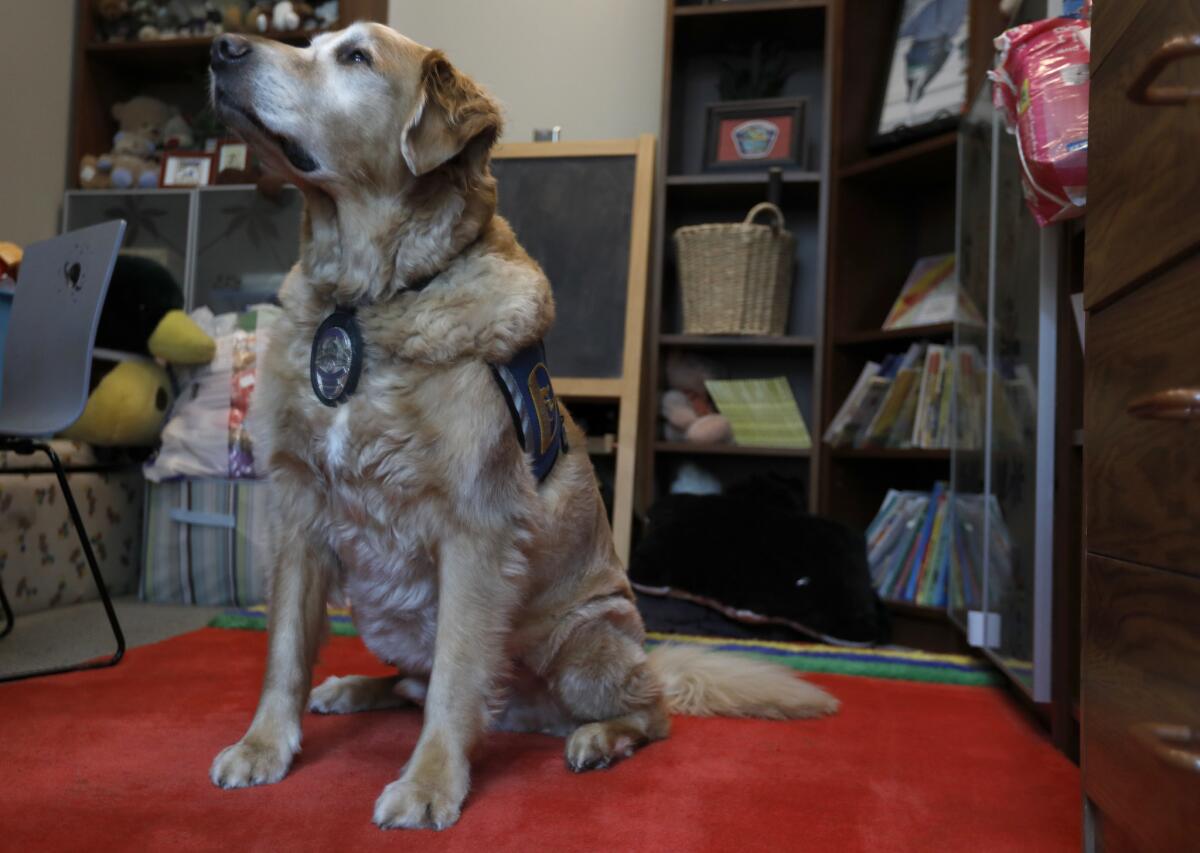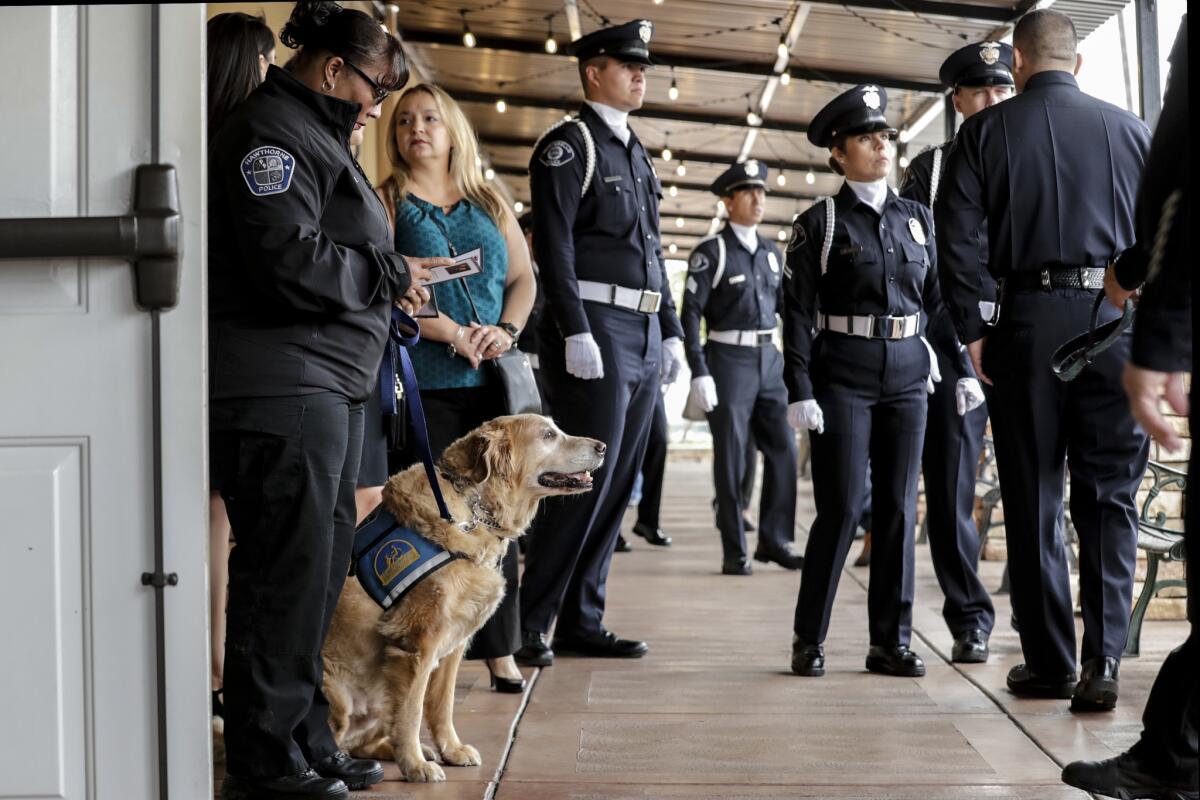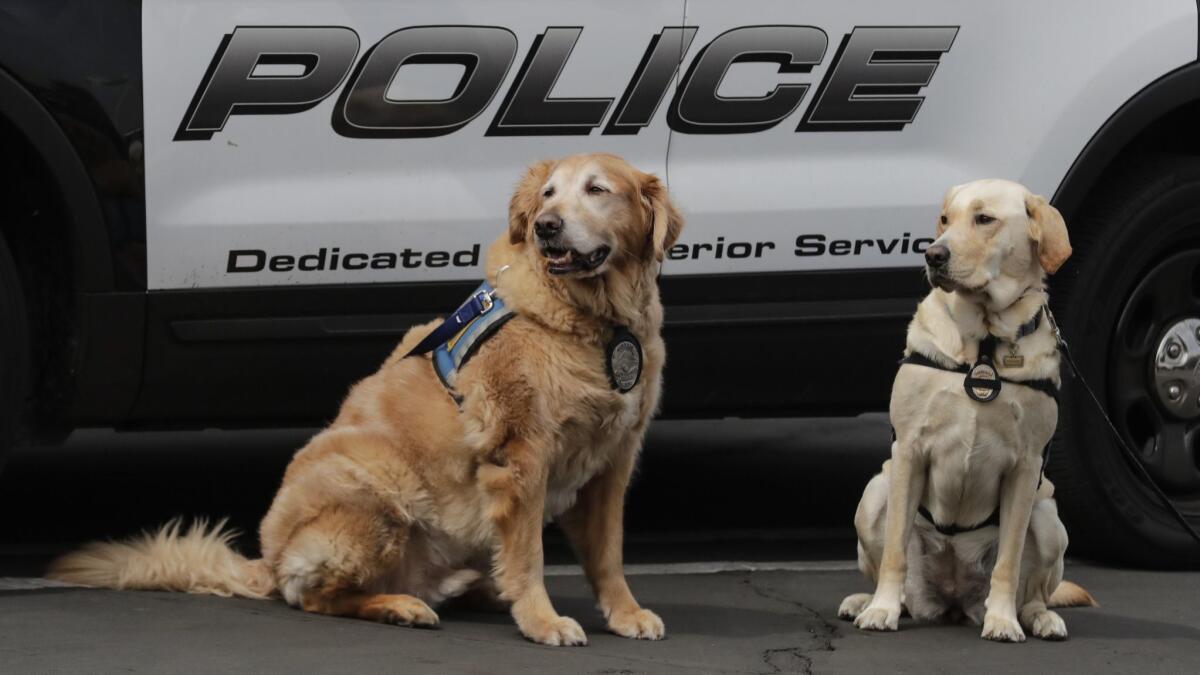These police dogs are trained to help survivors. They’re not here for the bad guys

- Share via
The most recognizable police dogs are those that can sniff out drugs and bombs, or the tough K-9s that can take down a suspect with their teeth.
Scottie, Raider and Meredith are not that kind of dog. Their mission is far different, and their duty lies with survivors of trauma, witnesses of tragedy or anyone in need of comfort.
“Dogs help people in a way that humans may never be able to,” said Erin Lennox, a public safety dispatcher with the Corona Police Department and one of Raider’s handlers.
Animals that are trained to provide emotional support have been popping up at hospitals, nursing homes and college campuses throughout the country. In law enforcement, they’re still an uncommon breed, but their numbers are growing.
Many of these so-called facility dogs come from Canine Companions for Independence, a California-based nonprofit founded in 1975. The group has placed 19 dogs in criminal justice systems across the Southwest. Three are attached to police stations in Southern California.
The first in the state — and one of the first police facility dogs in the country — was Scottie, a golden retriever who began working with the Hawthorne Police Department in 2012.
The 9-year-old K-9 was called into duty in April after a horrific shooting. During a child-custody exchange outside the station, a mother was killed in front of her 17-month-old son. That night, Scottie slept alongside the boy in a Police Department room filled with books and stuffed animals.
“He’s there to be a comfort. It’s wonderful to see him work,” said Scottie’s handler, Officer Lameka Bell.
When Bell got Scottie seven years ago, many officers initially dismissed the idea of bringing on a dog tasked solely with trauma support.
“You don’t bring lovely, happy animals into a police department. It’s always the big guns,” Bell said.
But Scottie has since become a valuable member of the force.

Every morning, he and Bell visit each office, from the records department to the mailroom, with stops at the gang unit and the jail, where Scottie is greeted with hugs and smiles and the occasional treat.
Some days are light. The partners might attend community outreach events, such as coffee with a cop, a trip to a school or a hospital tour.
Others are more difficult. Scottie sometimes will sit with children of abuse who’ve been brought in to take photos of their bruises. Occasionally, he’ll accompany a woman into a room as a rape kit is performed.
“We work the hotline at YWCA. If a person calls in who’s been raped, we meet them at the rape center,” Bell said. “Scottie goes into the room and sits with the victim.” The woman is given control over Scottie’s leash while a doctor examines her.
The dogs are free through Canine Companions, but the application process often takes more than a year. Extensive training ensures each dog has the right temperament.
Once on the job, facility dogs are regularly checked to ensure that the stress of their work doesn’t affect them.
“We’ve been together long enough where I know when he’s had enough,” Bell said of Scottie. “You don’t want to tire or agitate a dog.”
When they’re off the clock, the dogs live with their handlers as pets, playing fetch or lounging with the rest of their humans. They also get plenty of attention and rest throughout their work day.
Dogs help people in a way that humans may never be able to.
— Erin Lennox, one of Raider’s handlers at the Corona Police Department
Initially there wasn’t a blueprint for how these kinds of dogs should be used at a police station, but by the time Raider and Meredith came around, Bell was able to consult.
Raider joined the Corona Police Department in 2018 and has assisted on some tough cases.
For more than a year, as prosecutors laid out the horrifying abuse of 13 children at the hands of their parents, the 3-year-old yellow Lab was a steadfast presence, both in and out of the courtroom.
Amid the weighty conversations of neglect by David and Louise Turpin, who pleaded guilty to more than a dozen felony counts involving the torture and imprisonment of their children, the siblings came to rely on Raider’s companionship.
At the request of the children, who at the time of their parents’ arrest ranged in age from 2 to 29, the dog bore silent witness as their mother and father were sentenced to 25 years to life in prison in April.
Adam Roulston, a Corona police patrol sergeant and one of Raider’s handlers, said that while it’s up to the trainers to decide where to take their dogs, he’s learned the dogs usually decide which person to approach.
When everyone else is focused on the primary victim, Raider often heads in the direction of someone experiencing secondary trauma.
“He’ll lay on their feet or sit on them. Then they’ll break down,” said Roulston, who learned of police facility dogs after reading about Scottie.

Meredith, a 3-year-old yellow Lab who joined the Redondo Beach Police Department in 2017, spends most of her time with teenagers who have faced their own traumas.
The dog has been a steady presence inside a Redondo Beach high school. She and her handler, Sharon Rose, a community services K-9 specialist, are typically stationed inside an office at the school.
Rose said that once students realized Meredith’s job wasn’t to monitor their activity, trust was established. Visitors now frequently stop by the office to sit with Meredith, taking a momentary reprieve from their daily stresses.
The Lab has also been a source of comfort to the grieving.
In November, Rose took Meredith to a memorial service in Thousand Oaks following the mass shooting at the Borderline Bar and Grill that killed a dozen people.
“It’s nice to provide people with that mental break you need in the middle of tragedy,” she said.

At a recent funeral for a Montebello police officer, mourners were met by two particular guests. Outside the church, those in attendance made their way to Scottie and Meredith. Some bent down, nose-to-nose with the dogs in a moment of laughter. Others mindlessly patted the tops of their heads, wiping their eyes behind sunglasses.
The dogs didn’t know the sound of bagpipes indicated the start of the service, the finality of goodbye. They didn’t know the dark clothes of their new friends signaled the somber occasion.
As the crowd filed inside, the two sat patiently, as good dogs do, ready to ease the burden of their fellow officers and loved ones.
More to Read
Sign up for Essential California
The most important California stories and recommendations in your inbox every morning.
You may occasionally receive promotional content from the Los Angeles Times.














